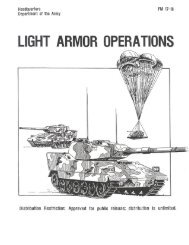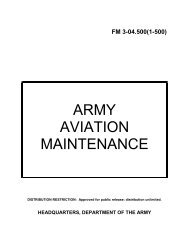AIR DEFENSE ARTILLERY REFERENCE HANDBOOK
AIR DEFENSE ARTILLERY REFERENCE HANDBOOK
AIR DEFENSE ARTILLERY REFERENCE HANDBOOK
Create successful ePaper yourself
Turn your PDF publications into a flip-book with our unique Google optimized e-Paper software.
FM 44-100-2<br />
4-40. Postboost. The EO TSG provides in-flight target and missile status<br />
update to the missile via the radar. The booster then separates. The radar<br />
provides the EO TSG with the kill vehicle (KV) and target status.<br />
4-41. Midcourse. The EO TSG provides in-flight target update to the KV via<br />
the radar. A divert and attitude control system (DACS) provides the KV with<br />
angle of attack and roll control. The KV has a self-contained cooling system<br />
that cools the seeker when in the IR operation. Seeker cool down begins prior<br />
to acquisition.<br />
4-42. Hand-over and Acquisition. The EO TSG provides final in-flight<br />
target update and target object map (TOM) to the KV via the radar. The<br />
TOM is designed to display object details and includes range, altitude, speed,<br />
and threat class. The shroud separates from the KV. The seeker begins<br />
acquisition mode. The KV matches the seeker scene against the TOM. The<br />
KV designates the target and initiates a track file.<br />
4-43. Target Track. The KV downlinks processed homing data. The KV<br />
steers to aimpoint based on radar estimates and the thrusters’ control of the<br />
KV attitude.<br />
4-44. Engage. The KV resolves the target image and determines the final<br />
aimpoint. The KV diverts to intercept and downlinks homing data.<br />
4-45. Impact and Target Destruction. The KV hits the target with<br />
tremendous kinetic energy to destroy the TBM. The radar updates the EO<br />
TSG data and then conducts kill assessment.<br />
Communications Equipment<br />
4-46. Many different types of communications equipment is organic to the<br />
THAAD battery. Each has different characteristics and multiple potential<br />
uses. These items consist of radio terminal sets, telephone sets, and<br />
communications processors. Together they makeup the heart of the THAAD<br />
communications system and are described in the following paragraphs.<br />
4-47. AN/GRC-193A Radio. The AN/GRC-193A is a long-haul EO HEU<br />
secondary radio communication network which supports the air defense<br />
coordination net (ADCN).<br />
4-48. AN/GRC-226 Radio. The AN/GRC-226 UHF (band 3 only), 15 channel<br />
radio operates in the 225 – 400 MHz band. This radio is compatible with<br />
radios used in the ACUS network. Two AN/GRC-226 radios are installed in<br />
each LCS. The radio provides line-of-sight communications for both voice and<br />
data. This is a bulk (trunk) encrypted communications link containing<br />
multiplexed voice and data circuits. Each set is comprised of a receivertransmitter,<br />
a baseband assembly, and an antenna assembly.<br />
4-49. AN/GSQ-240 JTIDS Class 2M Radio. The JTIDS provides a jam<br />
resistant ground-to-air and ground-to-ground data communications. JTIDS is<br />
a high-speed data radio that operates in a time-shared data network<br />
providing access to theater EO surveillance and targeting information<br />
network via a time division multiple access (TDMA) architecture in the 960<br />
MHz to 1215 MHz frequency range. Within the battery, JTIDS supports the<br />
EO data communications between the EO TSG and the SSI. The JTIDS<br />
4-13











